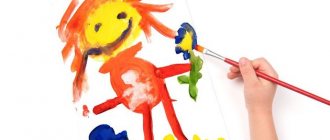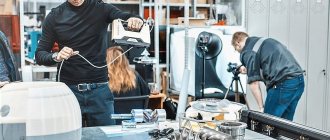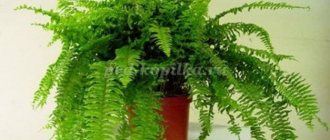The child learns about the world around him visually and experimentally. His knowledge is based on what he saw, heard and felt on his own. In addition, children's attention is fixed only on those objects that are interesting to them. In this regard, it is better to present any information to a child in the form of a game or experiment so that it is better remembered and finds practical application.
Water is a substance without which life on our planet would not have formed. It surrounds us constantly in everyday life and is even part of the human body. Experiments with water will be excellent educational entertainment for a child and his parents. The huge advantage of such experiments for children is that they themselves can become not just observers, but also participants in the game. Such a pastime will allow you not only to enjoy magic tricks, but also to study the basic properties and characteristics of water.
Experiments with water for kids
Young children, more than anyone else, are ready to absorb new knowledge. However, you need to choose a way to present them so that it is interesting to the kids. Water experiments are ideal for playing with children. However, experiments need to be selected so that the child not only enjoys the resulting trick, but also understands its meaning. IQ Club offers several common water experiments for preschool children.
Shape of water
You can start with a simple experiment for children 3-4 years old who generally know little about the world around them. For the experiment, you will need different objects into which you can pour water: a glass, a vase, a bucket, and a table surface will also work. The containers must be transparent so that the child can clearly see the water in them.
The essence of the experiment is that the child is shown how water takes the shape of the object in which it is located. You can also pour some liquid onto the table and show how it spreads.
Water expansion
In order for children to learn about one more property of water, you need to take a 1.5-2 liter bottle, colored electrical tape and the water itself, of course. It is better to carry out the experiment in winter, when the temperature is significantly lower or if there is a large freezer where the bottle can be placed vertically.
Algorithm for conducting an experiment with water:
- Fill the bottle about halfway with water;
- At the liquid level, apply colored electrical tape in a circle;
- Leave the bottle in the cold or in the freezer for several hours in an upright position;
- After the water has completely frozen, show the bottle to your child.
The experiment allows the child to independently verify that the ice has formed much higher than the level of the applied electrical tape. So he will understand that when frozen, water expands.
Growing Crystals
A very simple but beautiful experiment with water and table salt can be done at home and surprise your baby. For the experiment you will need salt, warm water, a woolen thread or twig and some kind of jar. You need to pour water into it and dissolve a large amount of salt (so much that a precipitate begins to form). The thread is immersed in the solution and left alone for 3-5 days. After which the child can be shown the resulting crystals on a string and explained how they appeared.
Flip trick
Many people believe that if you turn a glass of water upside down, it will simply spill out, although this statement is completely false. For the experiment, you only need thick paper, such as cardboard. Pour water into a glass, cover it with a piece of paper and turn it over sharply. Now you can let go of your hand, and the liquid will not go anywhere. The point is that the air pressure outside the glass is much greater than inside it. Therefore, the paper stays on the edges and the water does not spill out.
Experience with arrows
Water refracts light, so objects in it appear larger than they really are. You can verify this by putting a tennis ball, for example, in a jar of water. But it is much more interesting to carry out the following experiment: draw three arrows on a landscape sheet as shown in the photo, and place it vertically.
Next, place a transparent (in kindergarten it is better to use a plastic) jar in front of the sheet and gradually fill it with water. And a miracle will happen - the arrows will change direction!
By moving the jar along the sheet, you can fully appreciate the visual effect.
++
Experiments with water for elementary school
At primary school age, you can begin to study the most important properties of water. For example, without much difficulty it will be possible to determine whether water has a taste, what color it has, and other simple characteristics. But children at this age will be interested in complex experiments with water. Take the advice of the IQ club and conduct the following types of experiments with the liquid around us.
Finding the way
The experiment can be carried out using a regular napkin, multi-colored markers and, of course, water. To do this, unfold the napkin and cut a long strip of small width, but for its entire length. Place multi-colored dots in the form of beads across the entire surface of the strip. Dip it into a glass of water, not reaching the end a few centimeters. The child will see that the water spreads not only downwards, but also upwards, staining the napkin with spots of the colors with which the dots were placed. Explain to your child after the experiment that the essence of the experiment is how water spreads along any path it finds. In this case, they were cellulose fibers of the napkin.
Dissolution
Pour the water for the experiment into the glass to the brim. Then dissolve salt or sugar in it (it is better to take a warm liquid) and mix gently. The child will see that despite filling the glass with water, a sufficient amount of sugar or salt can be added there, because there is free space between the molecules of the substance. In addition, this experiment will show that at a certain point the crystals stop dissolving and begin to precipitate.
Boiling Features
A simple, but at the same time educational experiment even for adults is carried out as follows:
- To experiment with water, take a handkerchief and an elastic band;
- The handkerchief must be wetted and wrung out well, and then secured with an elastic band on the surface of the glass, closing it;
- In the center, press the scarf so that it is immersed in water a couple of centimeters;
- The glass is sharply turned over and at the same time the bottom is hit with your hand.
The meaning of the experiment is quite simple: boiling water at the moment of impact is formed due to the fact that air is sucked through a handkerchief and must pass through a barrier in the form of water, which means that bubbles will appear on its surface.
Self-inflating balloon
Only an adult should carry out the following experiment as it involves a chemical reaction. For a child, such an experiment will seem more like a trick. Its essence:
- Add a teaspoon of baking soda to a bottle of water and dissolve;
- Separately, mix lemon juice with 3 tablespoons of vinegar;
- The resulting mixture is added to the bottle;
- You need to immediately put the ball on the neck, because the reaction will happen quickly;
- To avoid holes allowing air to pass through, the ball is wrapped with electrical tape.
After the components of the mixture enter into a chemical reaction, carbon dioxide is produced, the pressure of which helps to inflate the balloon.
Rainbow water
To make experiments with water more entertaining for preschoolers, it is better to paint the water in different colors using ordinary watercolor paints. For the next experiment you need paints, granulated sugar, a glass glass, water, a syringe, and four small glass cups.
- There is no need to pour sugar into the first glass, half a teaspoon of sugar should be thrown into the second, a full teaspoon of sugar into the third, and one and a half teaspoons into the fourth.
- Now you need to add water to each glass and stir the sugar.
- For the first, take red and mix it, for the second - green, add black to the third, and add yellow to the fourth.
- Then you need to take a syringe and draw water from the first glass of red water without sugar. Pour the contents of the syringe into an empty prepared glass.
- Next, using a syringe, draw green water from the second glass, in which half a teaspoon of sugar is dissolved; the syringe must be lowered to the bottom of the glass with the red water collected and slowly release the water with green paint.
- Now the same procedure should be carried out with the third glass, where the water is black and contains one spoonful of sugar. You need to release it from the syringe in the same way as the previous step.
- And there was a fourth glass left. Everything is the same - water is drawn from it using a syringe and released to the bottom of the glass.
At the end of the experiment, you can notice how the glass turned out to be “rainbow water”; all the colored layers of water did not mix, but were located one after the other, having clear boundaries. The more sugar added, the greater the density of the water, which explains the lack of mixing. The more colors you use, the more colorful and visual the experience will be.
Interesting tricks for teenagers
Children in middle school have already learned a lot in science lessons, so they won’t be surprised by ordinary magic tricks. However, you will still be able to discover several magical properties of water. Some of the experiments with water that the IQ club offers will help you better understand its physical and chemical properties.
The water cycle
At school, from the first grade on, children are taught about the water cycle in nature, but this experiment will allow them to demonstrate it clearly. For the experiment with water you will need: a metal plate or baking sheet, a 3-liter jar, 5 ice cubes and a little more than a glass of boiling water. Execution algorithm:
- The bottle is placed on a hard surface and boiling water is poured to the bottom, about 3-4 cm;
- Ice is placed on a plate, and it is placed on top of the bottle so that the cubes are directly above the neck;
- The steam that is formed from boiling water will rise upward, but there it will meet an obstacle in the form of a cold plate and condense again;
- The result of the experiment will be a cloud formed inside the jar.
Water extraction
Children always like different adventures, so you can add a little playful aspect to experiments with water. Let's imagine that we find ourselves on a desert island and we need to get drinking water. The island is naturally surrounded by an ocean of salt water. However, it is possible to obtain fresh liquid for yourself. How it is carried out:
- water for the experiment is diluted with salt in a basin to imitate sea salt;
- A plastic cup is placed at the bottom of the basin;
- Pebbles are placed inside so that it does not float up (the edges of the glass should be above the water level;
- Cover the top of the basin with cling film so that there are no gaps;
- A pebble stone is also placed in the center at the level of the cup;
- The structure is left in the sun.
The essence of this experiment with salt water is that in the sun it begins to actively evaporate. But there is no space where this can be done. Therefore, the liquid condenses again on the surface of the film and runs down its walls into the glass.
In chemistry, teenagers will be able to conduct many more experiments with different states of water. They will be convinced that many substances have a higher density than this (it is not for nothing that the density of water is taken as one). The IQ Club recommends conducting those experiments at home that are forgotten during the learning process, so that the child develops comprehensively and is interested in the world around him.
Matches experiment
For the first experiment with water for preschoolers, you will need a glass glass, watercolor paints, a deep plate, and plasticine. An experiment using water will clearly show how air pressure changes during combustion.
- You need to pour water into a glass, add any color of paint to it with a brush and stir, this is necessary for the clarity of the experiment.
- Next, put a piece of plasticine at the bottom of an empty plate, into which insert two matches.
- Pour colored water from a glass into a plate.
- Under adult supervision, you need to light these matches and cover them with an empty, dry glass.
As a result of a simple experiment, the matches go out, and the colored water begins to rise up. This happens because during combustion the air pressure in the glass becomes less than outside.
colorful lamp
Such spectacular experiences with preschool children are especially popular.
- Mix half a glass of sunflower oil with the same amount of water, add dye.
- Take an aspirin tablet and drop it into the bottom of the container with the resulting mixture.
The aspirin begins to fizz and mix the oil and water, and the paint droplets begin to dissolve. A very beautiful sight. For illumination, you can direct the beam of a flashlight.





